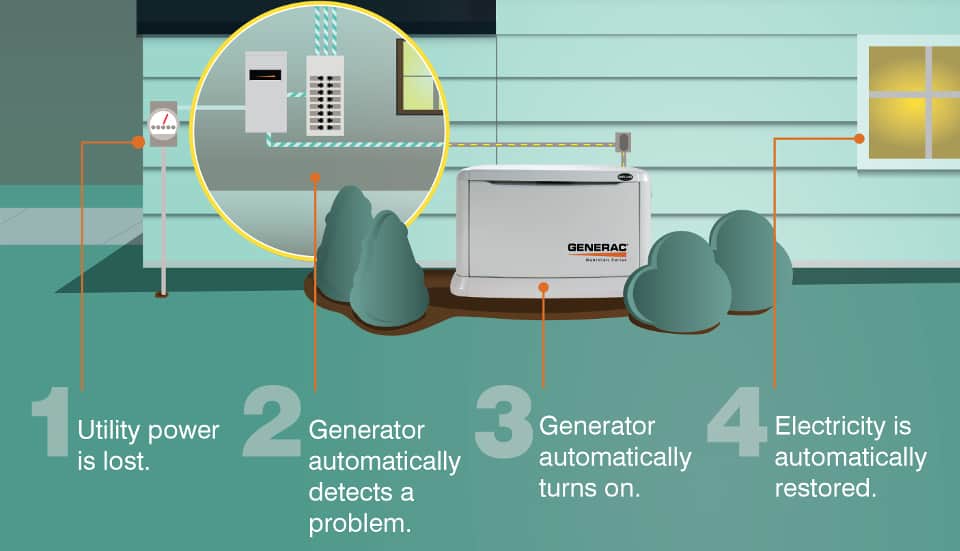Standby Generator Components - How It Works

Natural disasters and storms leave local electric utility distribution systems in ruins and residents without power for days or sometimes weeks. With any luck, the damage isn’t too bad and some customers find their power restored within a day of losing it. Unfortunately, even a day is too long for refrigerators and freezers. It doesn’t take a whole day without power to flood a basement when the sump pump doesn’t work.
The solution to the power problem comes in the form of a home standby generator. They work automatically, operate on municipal natural gas or your home’s propane tank, and alleviate the worry of frequent power outages caused by aging grid infrastructure.
Home Standby Generators provide safety and peace of mind. While you’re at work, on vacation, or away on business, they monitor the power 24 hours a day and detect outages the moment they occur. Within just seconds, the generator starts and supply power to the home. The refrigerator stays cold and the sump pump runs. Lights, televisions, and electronics all get the power they need.
3 Reasons to Invest in a Generator for Your Home
Home Standby Generator for Backup Power

Power Outages in Scattered City Neighborhoods
The standby generator is a permanently installed appliance with a natural gas or propane engine (diesel-powered standby generators are also available) to generate utility-quality power within moments after the outage occurs. The main components include the engine which powers the machine. Engines sizes match the power capacity of the standby generator. Larger capacity means it requires more power to turn the generator which produces electricity. Engines range from two to eight cylinders.
The generating unit itself—usually referred to as an alternator—produces the same alternating current that your electric utility provides. It is clean current which means that its frequency is stable, the voltage does not fluctuate, and the generator can supply enough reserve current to start motors and handle fast-changing loads—like when the central air conditioner turns on.
A microprocessor-based controller handles a myriad of functions. It starts the generator and prepares it to take the load. Runs an exercise cycle to keep the engine lubricated and protect the seals. Performs diagnostics and notifies you when there is a problem. It can even notify your dealer when the time arrives for service. With remote monitoring and access, you can receive text alerts, emails, and access the controller.
Liquid-cooled generators have the largest engines and include a cooling system similar to one found in an automobile. A pump circulates coolant through the engine to a radiator. A fan blows air through the radiator to remove heat from the coolant which then recirculates back through the engine. Liquid-cooled generators are well-suited to hot environments where the ambient temperature cannot adequately cool an air-cooled generator.
Standby Generator Buyer Guide: What Size Generator Do I Need?
Automatic Transfer Switch
 The Automatic Transfer Switch (ATS) chooses the home’s power source. When the utility power meets acceptable standards, the ATS selects utility power. If the power quality becomes inadequate—such as a power outage—the generator controller starts the engine and gives it a few seconds to stabilize and then signals the ATS to switch the power source to the home standby generator.
The Automatic Transfer Switch (ATS) chooses the home’s power source. When the utility power meets acceptable standards, the ATS selects utility power. If the power quality becomes inadequate—such as a power outage—the generator controller starts the engine and gives it a few seconds to stabilize and then signals the ATS to switch the power source to the home standby generator.
In the process of switching to generator power, the ATS automatically isolates the home from the electric utility lines. Isolation prevents danger to utility workers and prevents generator overloads while protecting the generator from the return of utility current.
When the generator controller determines that the utility power has returned to acceptable levels and has stabilized, the controller signals the ATS to switch back to utility power, then prepares the generator for shutdown by operating a cooling cycle.
Some transfer switches include power management features that allow a smaller and more fuel-efficient generator to supply power to a more appliances by managing which appliances run. If two air-conditioners try to run at the same time, the power manager may force the second one to wait until the first completes its cycle.
Buyer Guide: Backup Generator Automatic Transfer Switch
Emissions
All internal combustion engines emit carbon monoxide within their exhaust. Rules exist to keep these emissions out of houses. Generator manufacturers give minimum standards, but local codes may specify different requirements. In general, codes usually require a five-foot minimum distance from any opening including windows, doors, and vents. The prevailing wind is also a consideration. If the wind usually comes from the west, choose a location toward the east.
Air-cooled standby generators make about as much noise as a central air conditioner, but the noise is different. Placement should respect your neighbors—don’t put it ten feet from their bedroom window. You probably shouldn’t schedule the exercise cycle for three in the morning unless your neighbors are far away.
Automatic Transfer Switches and Standby Generators
A Complete System
 The components of a home standby generator work together as a system. At the heart of everything is the generator’s controller which communicates with the transfer switch and operates the generator within a very specific set of parameters.
The components of a home standby generator work together as a system. At the heart of everything is the generator’s controller which communicates with the transfer switch and operates the generator within a very specific set of parameters.
Other generators can make do when a standby generator is not an option, but they just don’t have the same capabilities. Unsure what size you need or model to buy? Consult Norwall’s Power Calculator for help with sizing.
Sizing Guides Installer Locator Power Expert
